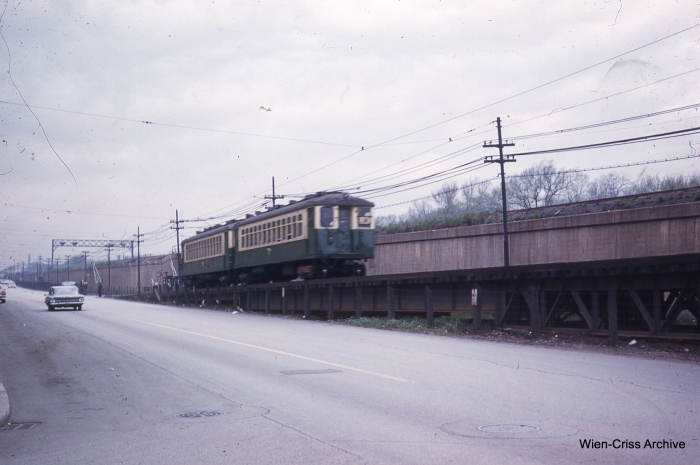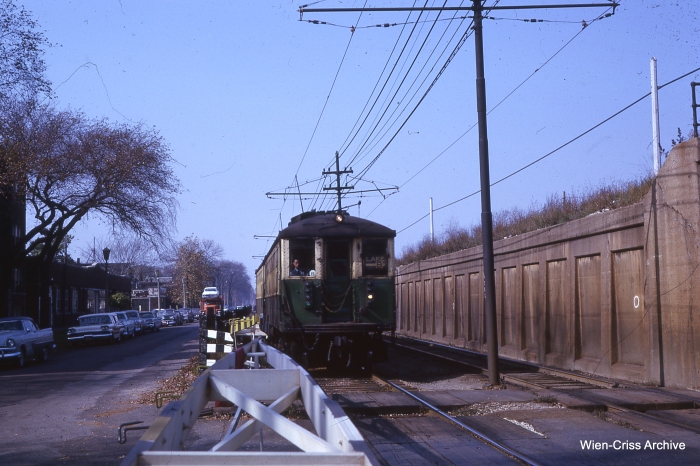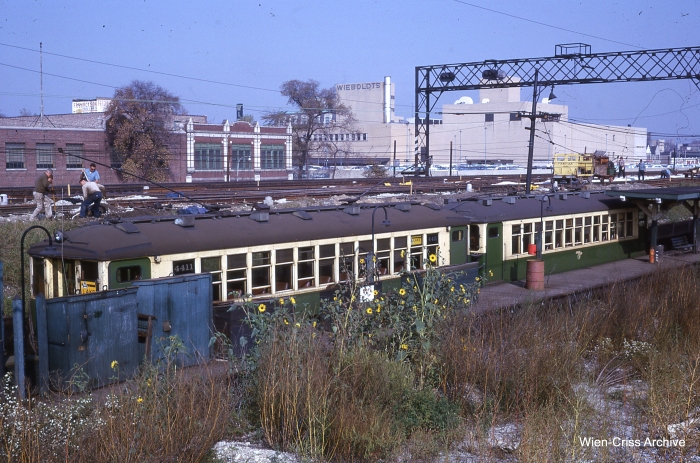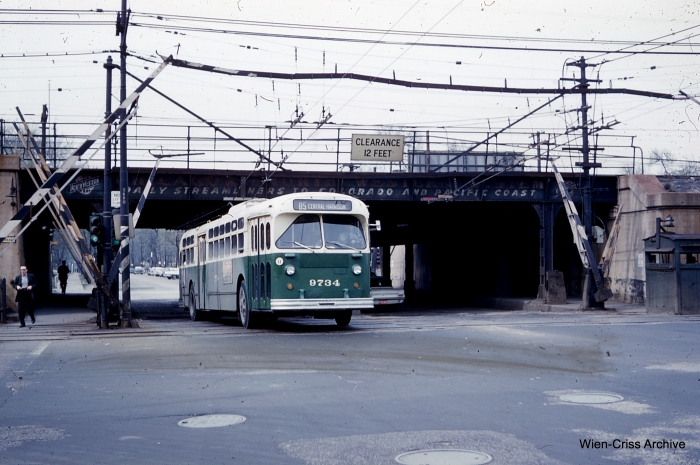It’s hard to imagine nowadays, but there was a time when not all of the CTA Lake Street “L” (today’s Green Line) was elevated. Until October 1962, the outer 2.5 miles between Laramie and Forest Park ran at ground level, with overhead wire instead of third rail. Since this was nearly 51 years ago, you’d have to be of a certain age to remember it. Fortunately, I rode this line frequently as a kid and recall it fondly.

South Boulevard at Home, October 1962. The photographer’s vantage point was a stairway leading to an old C&NW station. (Photo by Charles L. Tauscher, Wien-Criss Archive)
When Chicago’s “L” system was first built, some of the lines were extended to what were then sparsely populated areas. Much of Oak Park’s growth is the result of being served by two rapid transit lines for more than 100 years. But naturally, when these extensions were made, the private companies who built them were trying to get things going in the least expensive way possible. Therefore, ground level operation was the norm through Oak Park.
This persisted until about 50 years ago, when both Oak Park’s rapid transit lines were grade-separated within a few years of each other. The Garfield Park “L” was relocated into the Congress Expressway through this area in 1960, and the Lake Street “L” was elevated onto the Chicago & North Western embankment two years later.
What historian and author Bruce Moffat has called “everybody’s favorite side of the road trolley” was undoubtedly a ponderous and somewhat dangerous affair from an operational standpoint. There were numerous blind intersections, where cars and trucks and sometimes people would dart out in front of moving trains.
When the C&NW elevated onto their embankment (c1910), clearances with the rapid transit line were very tight- so tight, in fact, that CTA did not want to run curved-sided cars on the ground-level section. There were 22 viaducts with manually operated gates, and the gateman’s shacks also created tight clearances.
By the early 1950s, CTA had taken over from the bankrupt Chicago Rapid Transit Company, and considered ways to get rid of the three ground-level west side lines (Lake, Garfield, and Douglas). Douglas got cut back to 54th Avenue. Garfield might have met the same fate, except for the Congress Superhighway project. It morphed into the present-day Blue Line in the expressway median.
Around 1951, the CTA proposed cutting back Lake to Laramie, where the elevated structure ended. Oak Park, which billed itself the World’s Largest Village at the time (it has since lost the title, first to Skokie, then to Baniyachong of Bangladesh), did not like this idea and worked to find a solution.
Putting the outer end of Lake onto the C&NW embankment turned out to be a win-win for everyone involved. The CTA speeded up service and improved safety, while eliminating 22 grade crossings (and, most likely, at least 70 gatemen). The space vacated by the CTA got turned into parking spaces.
CTA built a new yard in Forest Park, which meant that CTA no longer had to store Lake trains on a third track on the elevated structure. At first, plans were to extend the rapid to the Des Plaines River, but in the end, Harlem became the last stop, as it had been before.
But C&NW came out ahead also. CTA had to pay rent of over $200k per year for using the embankment. And there was the matter of station closures. CTA and C&NW made a deal, whereby the latter agreed to close several close-in stations, ceding that ridership to the CTA. C&NW wanted to concentrate their efforts on the suburban market. Eliminating these stations made it easier for the CTA to relocate on the embankment.
Service was finally moved over to the embankment on October 28, 1962, over the course of a weekend. According to longtime CERA member (and former Director) Charles Tauscher, on Saturday the 27th, “L” service was cut back to Laramie, while the track connection was changed over from the old ramp to the new one bringing the line over to the C&NW.
The original connection to the embankment had an odd little dogleg in the track, which would often catch people unawares and throw them off to one side. Regular riders came to expect it. Fortunately, this section of curved track was smoothed out some years back.
Within two years of the 1962 changeover, the Lake line, which had been passed over with the 6000s, finally got new equipment. A significant part of the new fleet of 2000s, high-speed cars with air conditioning, were assigned to the Lake Street “L”, now that it was fully elevated.
CTA’s 6000s did not run on the Lake Street “L” much until the Blizzard of ’79, when they replaced more modern cars with burned-out motors. Here, for once the embankment worked against the “L” for a change. While the snow could fall through a steel “L” structure, it simply piled up on the embankment. The outer portion of Lake was closed for a week and had to be dug out by teams of workers armed with snow shovels.
Mr. Tauscher, an excellent photographer, took many photos of the Lake Street “L” in 1961-62, while the new alignment was being built. We present these for your enjoyment, courtesy of the Wien-Criss Archive. This will be the first of a series showing this very interesting operation.
-David Sadowski

CTA 4308 at Lake and Long on May 7, 1961. (Photo by Charles L. Tauscher, Wien-Criss Archive)

CTA 4388 in Forest Park on May 7, 1961. (Photo by Charles L. Tauscher, Wien-Criss Archive)

CTA 4388 at Central on May 7, 1961. (Photo by Charles L. Tauscher, Wien-Criss Archive)

Central Avenue, October 1962. (Photo by Charles L. Tauscher, Wien-Criss Archive)

The ramp up to Laramie, October 1962. (Photo by Charles L. Tauscher, Wien-Criss Archive)

CTA 4297 at Laramie, May 7, 1961. (Photo by Charles L. Tauscher, Wien-Criss Archive)

A West Towns bus crosses the Lake Street “L” at Ridgeland in October 1962. Today, this is the Pace 315 route. (Photo by Charles L. Tauscher, Wien-Criss Archive)

Harlem Avenue and South Boulevard in October 1962. (Photo by Charles L. Tauscher, Wien-Criss Archive)

The ramp to Laramie in October 1962. (Photo by Charles L. Tauscher, Wien-Criss Archive)

Ridgeland station, October 1962. (Photo by Charles L. Tauscher, Wien-Criss Archive)

A CTA #85 bus at Central in October 1962. (Photo by Charles L. Tauscher, Wien-Criss Archive)

A CTA trolley bus on Central in October 1962. (Photo by Charles L. Tauscher, Wien-Criss Archive)

Just east of Central in October 1962. (Photo by Charles L. Tauscher, Wien-Criss Archive)

October 1962. (Photo by Charles L. Tauscher, Wien-Criss Archive)

October 1962. (Photo by Charles L. Tauscher, Wien-Criss Archive)

A CTA #91 bus crosses the Lake line at Austin Boulevard in October 1962. (Photo by Charles L. Tauscher, Wien-Criss Archive)

October 1962. (Photo by Charles L. Tauscher, Wien-Criss Archive)

October 1962. (Photo by Charles L. Tauscher, Wien-Criss Archive)

A CTA #16 Lake Street bus in October 1962. This route used narrow buses for some years, but was eventually discontinued. (Photo by Charles L. Tauscher, Wien-Criss Archive)

October 1962. (Photo by Charles L. Tauscher, Wien-Criss Archive)

October 1962. (Photo by Charles L. Tauscher, Wien-Criss Archive)

October 1962. (Photo by Charles L. Tauscher, Wien-Criss Archive)

CTA 4301 with poles up at Laramie on May 7, 1961. (Photo by Charles L. Tauscher, Wien-Criss Archive)

4411 at Forest Park in October 1962. Note the Wieboldt’s store in the background, a local landmark. (Photo by Charles L. Tauscher, Wien-Criss Archive)

At Forest Park in August 1962. Note local the Wieboldt’s store in the background. (Photo by Charles L. Tauscher, Wien-Criss Archive)

CTA Central Avenue trolley bus 9734 on May 7, 1961. (Photo by Charles L. Tauscher, Wien-Criss Archive)

4367 at Central on May 7, 1961. (Photo by Charles L. Tauscher, Wien-Criss Archive)

The end of the line just west of Harlem Avenue in August 1962. Here, the embankment had to be built up in order to create the new CTA yard. (Photo by Charles L. Tauscher, Wien-Criss Archive)